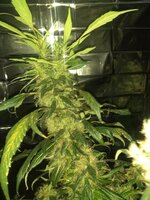- Thread starter
- #21
RichieRich6988
Well-Known Member
Very nice have you had any problems with moths or butterflies or their larva? I found that the last week on my outside grow there were signs of infestation. I always use praying mantis's in my garden and they took care of most of the problem but as I was drying out my buds I saw a few spinning a cacoon or trying to find a new food source. I just collected them and threw them into my turtle pond they love them. also thats what i use to water my plants with.She’s almost done! I’m thinking a week tops. Trichomes just started getting cloudy. Still no amber.



